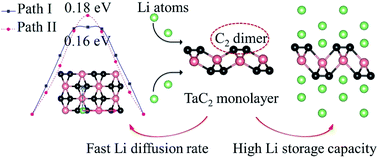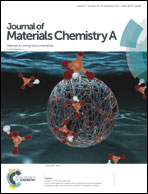Stable and metallic two-dimensional TaC2 as an anode material for lithium-ion battery†
Abstract
Relative to advanced cathode materials, anode materials have become one of the key factors to hamper the performance improvement of lithium-ion batteries (LIBs). Recently, two-dimensional (2D) transition metal carbides (e.g. MXenes) have drawn great attention due to their high Li storage ability. However, metal-rich 2D transition metal carbides as anodes usually need surface functionalization, leading to a decrease in the rate performances. Here, we propose that increasing the carbon composition in 2D TaxCy is beneficial for not only eliminating surface functionalization but also greatly improving battery performance. First-principles swarm structural searches were used to explore structures and stabilities of 2D TaxCy (x = 1 and y = 1–4, or x = 2 and y = 1). Besides reproducing the reported 2D TaC, TaC2 and Ta2C are found to be stable, and have high thermal stabilities. Metallic TaC2 and Ta2C provide good electronic conductivity. Intriguingly, carbon-rich TaC2 contains carbon dimers exposed on the surface, enabling it to directly adsorb Li atoms. After adsorption of two-layer Li atoms, its structural integrity is well preserved. The resultant specific capacity, diffusion energy barrier, and open-circuit-voltage (OCV) of TaC2 are much better than those of commercial graphite, f-Ti3C2 or the Ti2C monolayer. Compared with TaC2, TaC, and Ta2C as anode materials, the overall performance of carbon-rich TaxCy is better. Our work provides a useful strategy for designing new-type 2D transition metal materials for LIBs.



 Please wait while we load your content...
Please wait while we load your content...